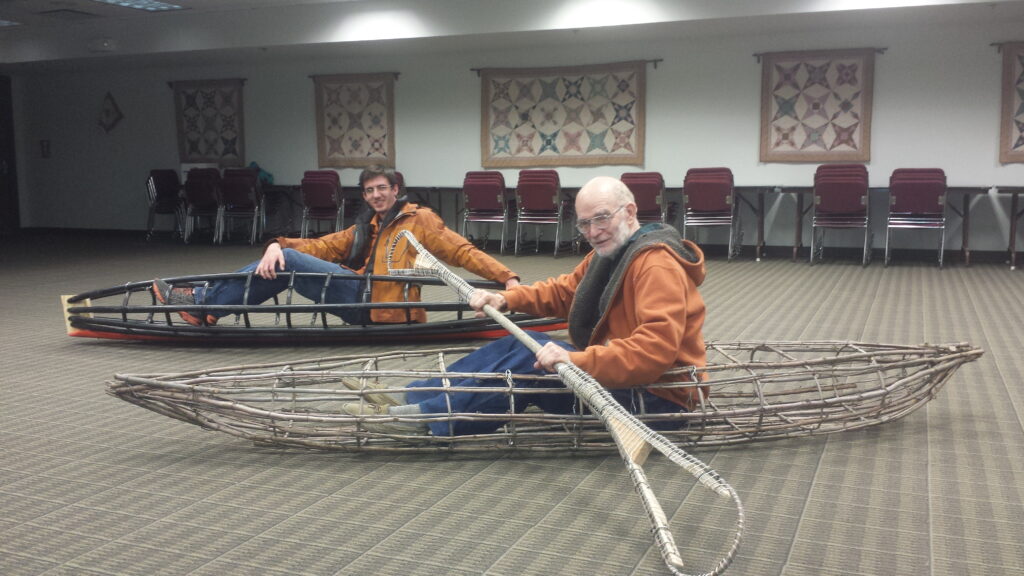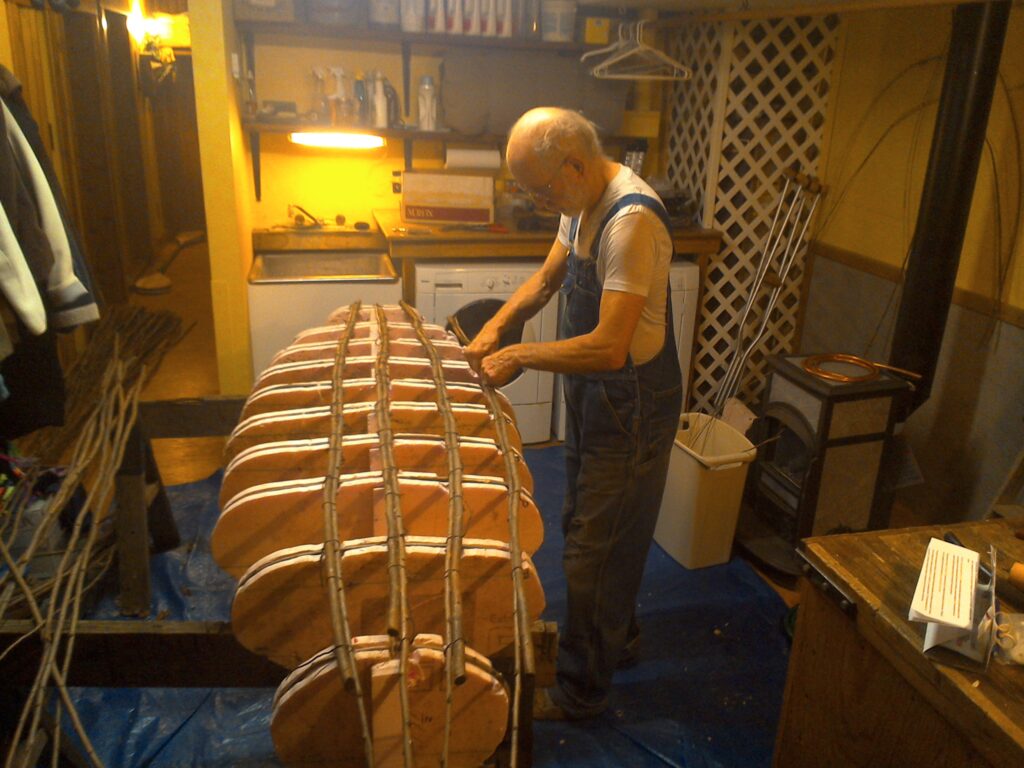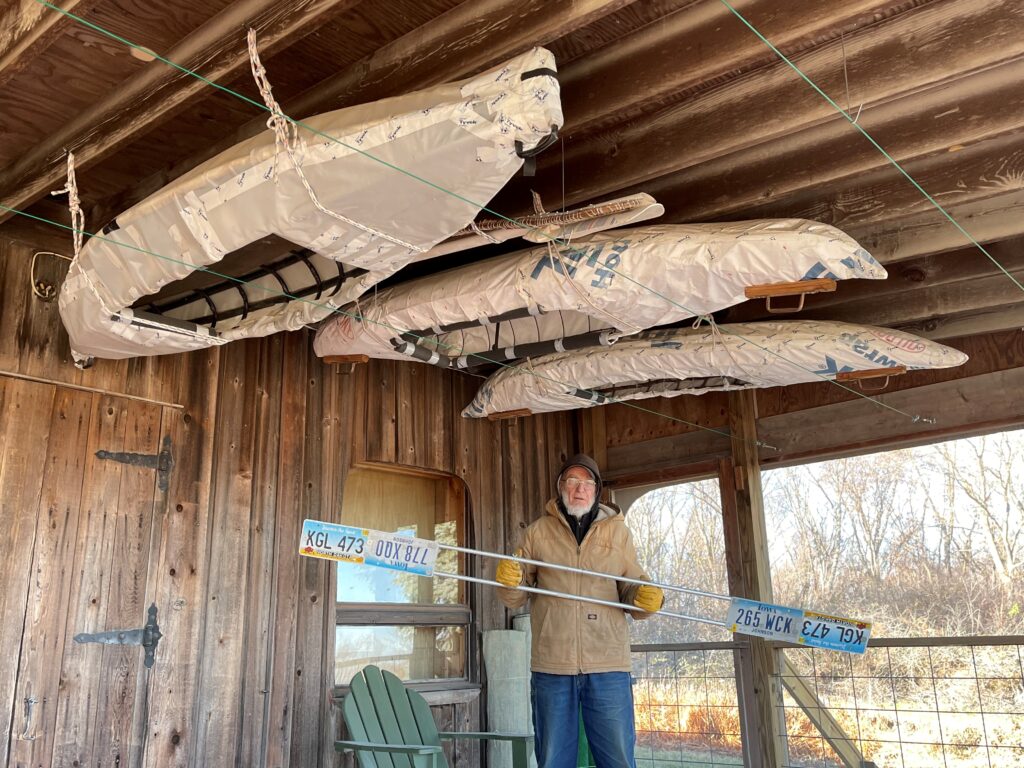A Winter Project: Build a Recycled Kayak
In 2014, Judy Joyce was creating Seize The Carp Day, proposed as an annual summer event to encourage people to come outdoors and celebrate our local creeks and river. For my part, I decided to build three different kayaks from natural and recycled materials and encourage guests to use them during the event. Today’s note offers some details regarding design and construction, with the idea that this could also be a winter project for your family or friends.
My first model has a frame of willow sticks wired together to form an open basket shaped like a kayak. Note that my center of gravity is slightly toward the back from center, the bow is a little more pointed and higher, while the stern is broader, lower and more blunt.
The oval willow ribs were bent around molds cut from scrap construction site pink-board, and the longitudinals, called strakes, were wired onto the ribs.
Willow sticks, at risk of breaking when being bent, were wrapped in a scrap of towel with a cup of boiling water poured into the towel and within a few minutes the willow became more bendable.

An outer skin of white Tyvek, leftover at a construction site, covers the willow frame, and a scrap of plywood shapes the floor to sit on. The paddle is a willow pole split and bent to shape the rim of the blades, with centers made of scrap Plexiglass, all tied together with nylon string, see first photo.
The second kayak was made from a piece of leftover steel sidewalk mesh, bent in numerous places to become the frame, with the excess cut away to accommodate the taper fore and aft. Like the willow stick model, the frame has a plywood floor and a Tyvek covering.
The paddle for this model is also made from metal. The handle is my old pair of my aluminum crutches, hopefully not needed again, and the blades are pairs of aluminum license plates.
The third model is framed from plastic. This one has a more traditional internal keel, cut from a scrap of orange gas pipe. The ribs and strakes are used plastic irrigation pipe. My friend Will is modeling the plastic frame in the first photo. He is a big man and it is a bit undersized for him. One construction flaw was that the old plastic in the ribs wouldn’t bend into ovals without kinking, so I added slender steel rods inside each before bending and couldn’t get them back out, so they add about eight pounds to the frame. It has a plywood floor and Tyvek skin, same as other models. The paddle is a length of plastic pipe with scoop-shaped blades cut from the sides of a plastic bucket.

And so here they are on the first Seize The Carp Day, August 2015. Susan Spears made the flags to advertise Bur Oak Land Trust. All three models are riding fairly high in the water, indicating the correct displacement for a slender adult plus a child. Children’s models could be smaller, but proportioned the same for reliable side-to-side stability.
When first used in summer 2015, all three models were watertight. But each summer since, after being dragged around a bit on grass, mud and sand, plus hauled around in a pickup truck, they all now have pinhole leaks where the Tyvek is stretched over the lower frame. Leakage last summer ranged from around a quart to a gallon per hour, which resides below the plywood seat board, and can be dumped out occasionally. They are lightweight and small enough that in winter I can store them up under the rafters of our porch, held in place with ropes.
So it’s been a fun little experiment in recycling, which can be done in winter if you have some space to work in your laundry room, storage area, garage or carport. Challenge your neighbor to make one also, and have races next summer.
Special thanks to Mark Jagnow, who was also deeply involved in the design and construction.
Tags: diy, do it yourself, kayak, Lon Drake, recycle, upcycle, winter project





